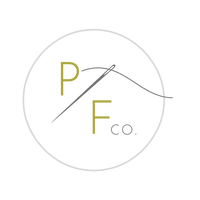This is the question I asked myself 2 days before Easter with 23 people coming over for Easter dinner - "Why not make napkins?"
You have to understand, it's not like I was in need of something extra to do, the "Must Do" list was full with cooking and cleaning, and any sewing time should have been spent on working on wips that were starting to look angrily at me.
But (I'm sure you understand), I had been wanting to make napkins out of the Fableism Monarch Grove fabric for MONTHS - since before Christmas - and the "Must Do" list always won out, so I didn't give in to the desire for handmade napkins.
Well, not this time. This time I shoe-horned the several hours of sewing to make 24 napkins into those two days and ended up with this gorgeous stack of napkins. We did also finish cooking, so don't worry, people got fed AND had beautiful napkins. Win win!
Oh, looks like I also used Fableism's Forest Forage!
And now, several months later, I still feel joy every time I pull these napkins out to use. They are cheerful and make our leftovers or homemade soup or takeout meals feel a bit more complete, like we are actually adults that have our lives together because we have HANDMADE NAPKINS!
A week ago, Fableism's newest collection - Canyon Springs - arrived in the shop, and I thought to myself, "Ooooo, these would make really beautiful napkins. Maybe I should make a few more!" So far I haven't, but I also haven't invited 23 people over for dinner yet, so maybe I'll just find an occasion that warrants that and then I can once again bust out a new set of napkins. :)
Or maybe, YOU want to make a set of napkins and just need the knowledge and encouragement to do it. Let me come to the rescue and provide both! Follow along with this photo tutorial and make your own stack of handmade napkins.
I decided that the perfect size of fabric to start out with for one napkin was roughly 22" x 22". Why that size? Well, I wanted generously sized dinner napkins, so decided that I could just use half of the width of fabric to maximize the fabric used, and it obviously had to be square(ish), so 22" x 22" was it!
I cut 2.5 yards of several fabrics off of the bolt and washed the fabric before starting. I planned to wash my napkins on warm water and throw them in the dryer, and this 100% cotton fabric WILL shrink, so I wanted to get the shrink out before hemming the sides so that they wouldn't pucker along the edges.
Once washed and dried, I was able to get 8 napkins out of each 2.5 yard piece by cutting the fabric in half along it's length, and then into 22" (ish) squares.
You'll see that the piece of fabric isn't a perfect square, and that's because I chose to scissor cut these along the grain of the fabric instead of using a rotary cutter and cutting out a perfect square. The Fableism fabric is looser weave than regular quilting cotton and easily gets skewed when tightly wound around the bolt. The wash and dry did most of the work of re-aligning the grain, but I didn't want the edges cut unevenly according to the woven design, so I prioritized cutting straight along the grain instead of cutting the perfect square. The fabric will continue to work itself back into straight on grain over time.
Press all four sides towards the wrong side of the fabric. I'm not going to tell you a measurement you have to use, just make it a tiny bit less than what you want your final hem to be. My first fold (there's another one coming!) is roughly 1/4", which works well on my machine - it's not a very large hem, but there's enough space that my sewing machine foot isn't slipping off of it like it might if the fold was very narrow.
Once you have all four sides pressed nice and evenly towards the wrong side, working one corner at a time, you are going to fold the napkin right sides together so that the fold perfectly intersects the corner. Here's two views to help explain:
Grab a straight edge and line it up perpendicular with the intersecting fold, lining up the edge of the ruler with the raw edge of the pressed fabric.
See how the ruler ends up right beside the fabric edges at the corner of the napkin? Yep, that's right. Draw a line on the napkin right there. I usually use a pencil or chalk, but I used a marker so you would see it well - don't worry, it will get folded into the hem!
Here's where this tutorial differs from most other mitered corner tutorials. Are you ready? Things are about to get silly (definitely exaggerating).
Most tutorials will now tell you to sew along that line with the fabric still folded. That should create a perfect 90 degree corner. However, I find with this softer cotton fabric, it tends to stretch out just a bit, and I end up with extra fabric at the corner and am unable to make the nice, sharp corner that I want.
So if I make that corner a bit sharper than 90 degrees; when sewing, the fabric will shape perfectly to a nice 90 degree corner. Feel free to experiment with this, that's what I did and how I figured it out!
Check out this photo of where the line is drawn and where my sewing line is. You can see that I started sewing on top of the drawn line but ended up a little bit left of the drawn line. This tightens up the corner just enough to have it lie nice and flat for the next steps.
Again, feel free to play around with the perfect angle that works with the fabric you're using. Maybe you won't need to do this, but this little trick has really helped my corners lie nice and flat and square.
Trim off the corner fairly close to the stitching line (good, sharp scissors that can easily handle this bulk are a bonus. I love my LDH Shears). I leave about an 1/8" of seam allowance. You can leave more, but that is going to add bulk to your corner, and so far, even with several washings, I haven't had those corners pop open!
Using something pointed (your finger, a chopstick, the Alex Anderson 4-in-1 tool), gently turn and push out the corner. You'll find that you've created the second fold with that stitch line! Magic!
Press that second fold down nice and evenly along all four sides. You should find that the first fold is laying flat under that second fold. If your corner stitch lines were nice and even, it should be fairly easy to get those sides nice and even all the way around.
(But listen, no judgement if you have to practice this on a few first. You should see the first ones I made... "nice and even" wasn't a thing. So maybe, use the bad fabric for the first one!)
Back at your sewing machine, sew down all four sides, right side up, rotating the napkin with the needle down at each corner. If your sides are all pressed nice and even, you should be able to hold a nice, even hem all the way around the napkin (that's the goal!). The seam has enough bulk to it that I am able to feel ahead of the sewing machine foot going over an area and tell if I need to adjust where the sewn line is (sewing closer to or further from the edge).
I backstitch a few stitches at the start and finish, using a thread matched with the main colour of the napkin, and using a stitch length of about 2.0.
This is how my corners end up looking, I am pretty pleased with these, but remember, I've already made 24 napkins. Yours are gonna look this good after 24 napkins too!
Done! Folded! Ready for dinner!
Once you've made a few, you will likely find that you can eyeball the stitch across the corner and not have to draw it on every time. Feel free to try that out after your first few napkins! Even if it's not perfect, I haven't had anyone comment on any slightly wonky corners.
Actually, nobody commented on my perfect corners either, so maybe the lesson here is that my guests aren't properly examining and appreciating my handmade napkins. Rude.
Will you make these? Do you have questions? Are there any tricky bits that I should do a better job of explaining? I'd love to see your stack of handmade napkins, so tag me in your makes, @piecefabricco!
Happy sewing and dining, friends!
-Kendra :)



















